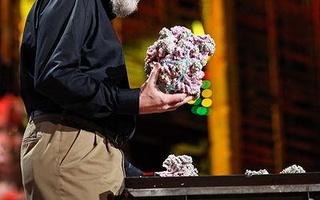Harvard Medical School professor George M. Church discussed the possibilities and potential dangers of genetic engineering on Wednesday. The lecture event, presented by the Harvard Museum of Natural History, covered a range of topics, including potential gains for genetic information and technologies and considerations of ethics and efficacy.
Church began the evening by highlighting the importance of genome testing, stressing that “whether or not you have family history, whether or not you [are of] a particular ethnicity, all of us are at risk for rare diseases.”
Genome testing has made advances in recent years, with the cost of sequencing an individual’s genome having decreased in the past decade. But further advances in genome testing, Church said, could “allow us to essentially see what’s currently invisible, to essentially see the genomes around us.”
Advances in the portability and affordability of genome testing, for instance, could lead to a sort of “handheld DNA sequencing device” that could dramatically impact diagnostics and field studies.
Moreover, Church said, “if you have an inexpensive way of [sequencing genomes] you can really start testing a lot of ideas about cause and effect,” with the potential to identify rare protective gene variants that could alleviate or eliminate some diseases.
“Your genetics is not your destiny,” Church said.
Church also discussed the possibility of de-extinction, bringing back species like the woolly mammoth. He predicted that the de-extinction process would largely depend on both ecological and economic considerations, in which species are judged both on their viability in modern ecosystems and their utility. He highlighted the woolly mammoth as an example of such a “keystone” species that could dramatically and positively impact the global ecosystem, citing his 2013 Scientific American article which outlined how mammoths could contribute to the reversal of global warming by keeping the tundra frozen.
“Letting the tundra melt,” Church said, “is the equivalent to burning all of the forests in all of the world and their roots two and a half times over.” Bringing back the woolly mammoth could be one important step toward preventing this catastrophic release of carbon, according to Church.
Church also briefly touched on human genetic enhancements, noting that changes in the modern environment and human behavior have framed the topic of altering one’s genome in terms of necessity.
“Our ancestors didn’t need any genetic enhancements to be able to sit for twelve hours a day and eat fatty, sugary foods, but we need enhancements that handle that altered environment,” he said. “If we go into space, we need enhancements that handle radiation and osteoporosis...or else we’re dead. So what seems like an enhancement in one generation becomes life and death in another generation.”
Church acknowledged, however, that the question of enhancements was a very “serious problem” and one that certainly calls for more discussion.
“The main ethical question about [human genetic enhancements] becomes whether it’s safe and effective,” he said.
Church concluded the evening by addressing concerns over genetic and bio-terrorism raised by several audience members. He said that those aiming to use genetic information and technologies for malicious purposes will be “even harder to deal with than the errors we [geneticists] will inevitably make.”
Some protections, including proper education of future generations and a strong emphasis on extensive surveillance, can be extended, he said.
“Not everybody has to be a synthetic biologist,” Church said. “And so they should all be under surveillance…. We [scientists] should be under scrutiny so that we don’t have access to the tools to make something dangerous.”
Read more in University News
Panelists Weigh Implications of Cyprus Natural Gas ReservesRecommended Articles
-
 Panel Discusses Genome Research
Panel Discusses Genome Research -
Fellow Wins Research PrizeErez Lieberman-Aiden, a fellow at the Harvard Society of Fellows, has won the GE & Science Prize for Young Scientists for his dissertation research developing a new method of determining the three-dimensional structure of nuclear DNA.
-
HSPH Study Links Sugary Beverages and Genetic Risk of ObesityHarvard School of Public Health researchers found that a greater consumption of sugar-sweetened beverages is linked with a greater genetic susceptibility to increased risk of obesity and high body mass index.
-
 George Church Visits Colbert
George Church Visits Colbert -
Lander Awarded $3 MillionEric S. Lander, founding director of the Broad Institute at MIT and Harvard, was one of 11 scientists awarded the inaugural Breakthrough Prize in Life Sciences Award, which recognizes scientists in the field of curing intractable disease and extending human life.
-
Washington’s Contradictory Science SpendingWhile we cut everything else, let’s cut the contradiction. Before we can understand the brain, our government must use it.













